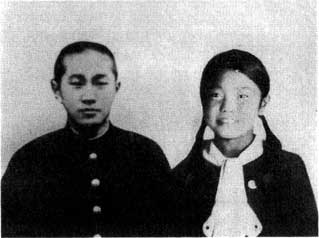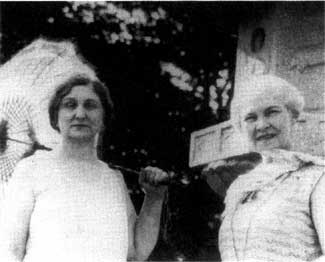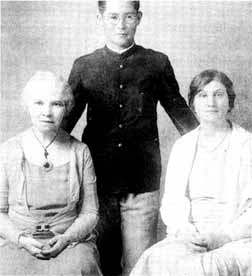
|
Traces That Remain:
A Pictorial History of the Early Days of the Bahá'í Faith among the Japanese
by Barbara R. Sims
edited by Sheridan Sims  |
chapter 29 | start page | single page | chapter 31 |  |
Chapter 30
They were among the first women to cast off the limitations of their time and circumstances, to step forth boldly to proclaim the Faith of Bahá'u'lláh in many parts of the world. They were cultured, educated, and received the respect of the people they talked to.

click here for larger image
This photograph was taken in Kyoto during Miss Root's final visit to Japan in 1937. Mr. Torii is sitting next to her. Behind them are Mr. Kikutaro Fukuta, who was visiting the Toriis, Miss Adachi (Mrs. Torii's sister) and Mrs. Torii.
There have been the questions, "What remains of the efforts of these great Bahá'ís? Where is the sprouting of the seeds that were sown?"
Future historians will no doubt recognize that the travels and teaching in the early days of women such as the above three mentioned went far beyond the service of the time, because during their travels they helped shape and influence the thinking of countless people, young and old, who were eager to listen to such women, coming from so far, with such new ideas.
In those days the audiences in Japan, which often were extremely large, were mostly composed of what we now call leaders, or future leaders of thought. There were news media people, representatives of various aspects of the government, academics, people eminent in many different types of professions. There were many thousands of them, as well as countless and numberless students, citizens of the future.

The picture Miss Root is holding (previous page), is that of Akira Torii and Miss Sumi Kinukawa, the fifteen-year-old daughter of a friend of the Toriis. Both young people died within a few months of each other. The two had not met but they both liked music and had similar tastes so the parents decided to make a composite picture of them.Miss Alexander took this photograph to Haifa when she made her pilgrimage in 1937. Knowing it would make him happy, she wrote to Mr. Torii that when she showed the picture to the Guardian he asked to keep it saying he did not have many photographs of Japanese.
Posterity will continue to pay homage to these remarkable women. Here we can only refer to isolated incidents in their lives.
Miss Root visited Japan four times, staying from two weeks to two months. The first visit, of two weeks, was in 1915. Miss Alexander had not been in Japan long herself but she had started activities. She arranged as many meetings as she could and introduced Miss Root to a newspaper reporter resulting in a long article about Miss Root's travels, and about the Faith.

Mrs. Ransom-Kehler spoke on the Faith at a Buddhist Temple, 1931. She is on the left and Miss Alexander on the right. Standing on the right is the Buddhist priest Mr. Morii.
During her first visit she encouraged Miss Alexander to write for the Faith. Miss Alexander started writing and continued all her life. For a person who did not consider herself a writer, Miss Alexander left a considerable amount of written material, articles, many of which were published and written talks which she could hand out for proper translation as she had seen Martha do. She wrote for Bahá'í magazines, sending her letters around the world. She also wrote short memorials when some of her friends passed away, Mr. Fukuta, Mrs. Maxwell and Mrs. Lua Getsinger. At the encouragement of Shoghi Effendi she wrote two books, one on the history of the Faith in Hawaii and the other a history of the Faith in Japan.
Miss Alexander felt she owed a great deal to Miss Root. She wrote of her friend, "Martha, who never sought rest, was continually my inspiration."
Miss Root's second and third visits were even more productive than her first. Miss Alexander had been living in Japan longer and had many contacts. Her second visit of two weeks

Miss Alexander and Mrs. Ransom-Kehler. Miss Alexander liked to take her friends to nearby Kudan Shrine as a background for photographs.
was full from the day she arrived. She spoke at various organizations, English clubs, the YMCA, Esperanto societies and informal groups at Miss Alexander's home.
Her third visit of two months was in 1930. At this time she attempted to meet the Emperor. This was not permitted. However, she was able to send some gifts along with a cable from Shoghi Effendi (see Ch. 31).
The high point of Miss Root's third visit was the first mention of the Faith on radio. Her subject was "The progress of the Faith on five continents." She read her talk in English and it was translated into Japanese. Later it was published in the daily newspaper, The Japan Times.
It was during this visit that she met Mr. Torii for the first time. When she left she gave him a small wooden and silver-inlaid box which had been given her by relatives of the Báb in Shiraz, Persia. He greatly treasured the box. Some fifty years

click here for larger image
Keio University law student K. Sudo asked Miss Alexander and Mrs. Ransom-Kehler to pose for this photograph. Miss Alexander and Miss Root had both spoken to the students so Miss Alexander was happy to have their efforts reinforced. She sent a copy of this to the Guardian. It was also published in a "Star of the West" volume.
later Mrs. Torii gave the box to the National Archives in Tokyo.
Miss Root's fourth and final visit to Japan was in 1937. She was the last Bahá'í to visit Japan for many years. This time she could not see her friend, Miss Alexander, who was on her pilgrimage to the Holy Land. Miss Root stayed three weeks during this visit, speaking in various cities, meeting Esperantists and other groups. She made an effort to meet all the Bahá'ís in Japan and had one last photograph taken with the Bahá'ís in Kyoto.
During her four visits Miss Root reached thousands of people, meeting many of them personally, speaking to large groups, by a radio broadcast and having articles published.
Mrs. Ransom-Kehler was a teacher of Bahá'í administration and she did much to deepen the group of Bahá'ís.
From Japan, Mrs. Ransom-Kehler went on to visit other countries. She was sent to Persia (Iran) by Shoghi Effendi to accomplish an important mission, but while she was there she was suddenly taken ill with small pox and passed away. The Guardian designated her as the first American martyr in his cable November 1933:
"Keith's precious life offered up in sacrifice to beloved Cause in Bahá'u'lláh's native land. On Persian soil for Persia's sake she encountered, challenged and fought the forces of darkness with high distinction, indomitable will, unswerving loyalty ... American believers grateful and proud of memory of their first and distinguished martyr ..."
Shortly before she became ill she wrote to Miss Alexander, "I still like Japan better than any country that I have visited and I often think with love and longing of the precious friends there ..."
Miss Alexander summed up her feelings about Keith when she wrote, "I am grateful to God that she came into my life."
 |
chapter 29 | start page | single page | chapter 31 |  |
|
|